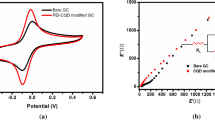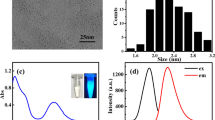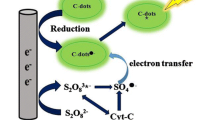Abstract
A chemiluminometric method is introduced for the determination of the stress biomarker, 3-nitrotyrosine (3-NT) based on the H2O2–NaIO4 reaction enhanced by cobalt and nitrogen-doped carbon dots (Co,N-CDs). In this chemiluminescence (CL) system, the emission proved to be originated from the excited-state Co,N-CDs (λmax = 504 nm). Comparing the effect of Co,N-CDs with that of some other metal ion-doped CDs and undoped CDs indicated the high efficiency of Co,N-CDs in the CL amplification (about 1980-fold). This was attributed to the fact that Co,N-CDs, in addition to other functions, could act as catalytic center, to accelerate the decomposition of H2O2 and to increase the number of hydroxyl radicals. It was found that 3-NT inhibits the action of Co,N-CDs by an electron transfer process, leading to a decline in the CL intensity of the system. Therefore, a new CL sensing platform was introduced for the assay of 3-NT in the range 5.0 to 300 nM with a detection limit of 1.5 nM. The probe was utilized for the analysis of biological samples.
Graphical abstract







Similar content being viewed by others
References
He Q, Chen Y, Shen D, Cui X, Zhang C, Yang H, Zhong W, Eremin S, Fang Y, Zhao S (2019) Development of a surface plasmon resonance immunosensor and ELISA for 3-nitrotyrosine in human urine. Talanta 195:655–661. https://doi.org/10.1016/j.talanta.2018.11.110
Kim Y, Lee J (2020) Advanced molecular recognition of 3-nitro-L-tyrosine: the use of zwitterion embedded molecularly imprinted mesoporous organosilica with sub-nanomolar sensitivity. Biosens Bioelectron 160:112216. https://doi.org/10.1016/j.bios.2020.112216
Bandookwala M, Sengupta P (2020) 3-Nitrotyrosine: a versatile oxidative stress biomarker for major neurodegenerative diseases. Int J Neurosci 130:1047–1062. https://doi.org/10.1080/00207454.2020.1713776
Jalili R, Amjadi M (2018) Bio-inspired molecularly imprinted polymer–green emitting carbon dot composite for selective and sensitive detection of 3-nitrotyrosine as a biomarker. Sensors Actuators B Chem 255:1072–1078. https://doi.org/10.1016/j.snb.2017.08.145
Bandookwala M, Thakkar D, Sengupta P (2020) Advancements in the analytical quantification of nitroxidative stress biomarker 3-nitrotyrosine in biological matrices. Crit Rev Anal Chem 50:265–289. https://doi.org/10.1080/10408347.2019.1623010
Teixeira D, Prudêncio C, Vieira M (2017) Development of a new HPLC-based method for 3-nitrotyrosine quantification in different biological matrices. J Chromatogr B 1046:48–57. https://doi.org/10.1016/j.jchromb.2017.01.035
Schwedhelm E, Tsikas D, Gutzki F-M, Frölich JC (1999) Gas chromatographic–tandem mass spectrometric quantification of free 3-nitrotyrosine in human plasma at the basal state. Anal Biochem 276:195–203. https://doi.org/10.1006/abio.1999.4361
Wayenberg J-L, Ransy V, Vermeylen D, Damis E, Bottari S (2009) Nitrated plasma albumin as a marker of nitrative stress and neonatal encephalopathy in perinatal asphyxia. Free Radic Biol Med 47:975–982. https://doi.org/10.1016/j.freeradbiomed.2009.07.003
Govindasamy M, Manavalan S, Chen S-M, Umamaheswari R, Chen T-W (2018) Determination of oxidative stress biomarker 3-nitro-l-tyrosine using CdWO4 nanodots decorated reduced graphene oxide. Sensors Actuators B Chem 272:274–281. https://doi.org/10.1016/j.snb.2018.05.138
Tiwari A, Dhoble SJ (2018) Recent advances and developments on integrating nanotechnology with chemiluminescence assays. Talanta 180:1–11. https://doi.org/10.1016/j.talanta.2017.12.031
Li Y, Zheng Y-Z, Zhang D-K, Li H-F, Ma Y, Lin J-M (2017) Enhanced chemiluminescence from reactions between CdTe/CdS/ZnS quantum dots and periodate. Chin Chem Lett 28:184–188. https://doi.org/10.1016/j.cclet.2016.07.020
Liu J, Chen H, Lin L, Lu C, Lin J (2010) Sensitized chemiluminescence reaction between hydrogen peroxide and periodate of different types of Mn-doped ZnS quantum dots. Chin Sci Bull 55:3479–3484. https://doi.org/10.1007/s11434-010-4059-6
Yan Y, Wang X, Hai X, Song W, Ding C, Cao J, Bi S (2020) Chemiluminescence resonance energy transfer: from mechanisms to analytical applications. TrAC Trends Anal Chem 123:115755. https://doi.org/10.1016/j.trac.2019.115755
Zhang L, He N, Lu C (2015) Aggregation-induced emission: A simple strategy to improve chemiluminescence resonance energy transfer. Anal Chem 87:1351–1357. https://doi.org/10.1021/ac5041605
Chen W-H, Vázquez-González M, Kozell A, Cecconella A, Willner I (2018) Cu2+ -modified metal-organic framework nanoparticles: a peroxidase-mimicking nanoenzyme. Small 14:1703149. https://doi.org/10.1002/smll.201703149
Shah SNA, Zheng Y, Li H, Lin J-M (2016) Chemiluminescence character of ZnS quantum dots with bisulphite-hydrogen peroxide system in acidic medium. J Phys Chem C 120:9308–9316. https://doi.org/10.1021/acs.jpcc.6b01925
Shah SNA, Li H, Lin J-M (2016) Enhancement of periodate-hydrogen peroxide chemiluminescence by nitrogen doped carbon dots and its application for the determination of pyrogallol and gallic acid. Talanta 153:23–30. https://doi.org/10.1016/j.talanta.2016.02.056
Wang DM, Lin KL, Huang CZ (2019) Carbon dots-involved chemiluminescence: recent advances and developments. Luminescence 34:4–22. https://doi.org/10.1002/bio.3570
Lin L, Luo Y, Tsai P, Wang J, Chen X (2018) Metal ions doped carbon quantum dots: synthesis, physicochemical properties, and their applications. TrAC Trends Anal Chem 103:87–101. https://doi.org/10.1016/j.trac.2018.03.015
Qian Z, Shan X, Chai L, Ma J, Chen J, Feng H (2014) Si-doped carbon quantum dots: a facile and general preparation strategy, bioimaging application, and multifunctional sensor. ACS Appl Mater Interfaces 6:6797–6805. https://doi.org/10.1021/am500403n
Gong X, Liu Y, Yang Z, Shuang S, Zhang Z, Dong C (2017) An “on-off-on” fluorescent nanoprobe for recognition of chromium(VI) and ascorbic acid based on phosphorus/nitrogen dual-doped carbon quantum dot. Anal Chim Acta 968:85–96. https://doi.org/10.1016/j.aca.2017.02.038
Zhong J, Chen X, Zhang M, Xiao C, Cai L, Ali Khan W, Yu K, Cui L, He L (2020) Blood compatible heteratom-doped carbon dots for bio-imaging of human umbilical vein endothelial cells. Chin Chem Lett 31:769–773. https://doi.org/10.1016/j.cclet.2020.01.007
Xu Q, Kuang T, Liu Y, Cai L, Peng X, Sreeprasad T-S, Zhao P, Yu Z, Li N (2016) Heteroatom-doped carbon dots: synthesis, characterization, properties, photoluminescence mechanism and biological applications. J Mater Chem B 4:7204–7219. https://doi.org/10.1039/C6TB02131J
Das P, Ganguly S, Bose M, Mondal S, Choudhary S, Gangopadhyay S, Das A-M Banerjee S, Das C (2018) Zinc and nitrogen ornamented bluish white luminescent carbon dots for engrossing bacteriostatic activity and Fenton based bio-sensor. Mater Sci Eng C 88:115–129. https://doi.org/10.1016/j.msec.2018.03.010
Delnavaz E, Amjadi M (2020) An ultrasensitive chemiluminescence assay for 4-nitrophenol by using luminol–NaIO4 reaction catalyzed by copper, nitrogen co-doped carbon dots. Spectrochim Acta A Mol Biomol Spectrosc 241:118608. https://doi.org/10.1016/j.saa.2020.118608
Zhang H-Y, Wang Y, Xiao S, Wang H, J-h W, Feng L (2017) Rapid detection of Cr(VI) ions based on cobalt(II)-doped carbon dots. Biosens Bioelectron 87:46–52. https://doi.org/10.1016/j.bios.2016.08.010
Liu G, Li B, Liu Y, Feng Y, Jia D, Zhou Y (2019) Rapid and high yield synthesis of carbon dots with chelating ability derived from acrylamide/chitosan for selective detection of ferrous ions. Appl Surf Sci 487:1167–1175. https://doi.org/10.1016/j.apsusc.2019.05.069
Huang S, Yang E, Yao J, Chu X, LIu Y, Zhang Y, Xiao Q (2019) Nitrogen, cobalt co-doped fluorescent magnetic carbon dots as ratiometric fluorescent probes for cholesterol and uric acid in human blood serum. ACS Omega 4:9333–9342. https://doi.org/10.1021/acsomega.9b00874
Zheng Y, Zhang D, Shah SNA, Li H, Lin J-m (2017) Ultra-weak chemiluminescence enhanced by facilely synthesized nitrogen-rich quantum dots through chemiluminescence resonance energy transfer and electron hole injection. Chem Commun 53:5657–5660. https://doi.org/10.1039/C7CC02041D
Dou X, Lin Z, Chen H, Zheng Y, Lu C, Lin J-M (2013) Production of superoxide anion radicals as evidence for carbon nanodots acting as electron donors by the chemiluminescence method. Chem Commun 49:5871–5873. https://doi.org/10.1039/c3cc41145a
Chen H, Li H, Lin J-M (2012) Determination of ammonia in water based on chemiluminescence resonance energy transfer between peroxymonocarbonate and branched NaYF 4 :Yb 3+ /Er 3+ nanoparticles. Anal Chem 84:8871–8879. https://doi.org/10.1021/ac302300z
Lin Z, Xue W, Chen H, Lin J-M (2011) Peroxynitrous-acid-induced chemiluminescence of fluorescent carbon dots for nitrite sensing. Anal Chem 83:8245–8251. https://doi.org/10.1021/ac202039h
Zhang S, Wu Y, Li H (2000) Chemiluminescence of cobalt (II)–hydrogen peroxide–hydrogencarbonate in the absence of luminescent reagents. Talanta 53:609–616. https://doi.org/10.1016/S0039-9140(00)00549-X
Tsikas D (2012) Analytical methods for 3-nitrotyrosine quantification in biological samples: the unique role of tandem mass spectrometry. Amino Acids 42:45–63. https://doi.org/10.1007/s00726-010-0604-5
Ng SP, Qiu G, Ding N, Lu X, Wu C-ML (2017) Label-free detection of 3-nitro-l-tyrosine with nickel-doped graphene localized surface plasmon resonance biosensor. Biosens Bioelectron 89:468–476. https://doi.org/10.1016/j.bios.2016.04.017
Author information
Authors and Affiliations
Corresponding author
Ethics declarations
Conflict of interest
The authors declare no competing interests.
Additional information
Publisher’s note
Springer Nature remains neutral with regard to jurisdictional claims in published maps and institutional affiliations.
Supplementary information
ESM 1
(DOCX 246 kb)
Rights and permissions
About this article
Cite this article
Delnavaz, E., Amjadi, M. A chemiluminescence probe enhanced by cobalt and nitrogen-doped carbon dots for the determination of a nitrosative stress biomarker. Microchim Acta 188, 278 (2021). https://doi.org/10.1007/s00604-021-04932-9
Received:
Accepted:
Published:
DOI: https://doi.org/10.1007/s00604-021-04932-9




